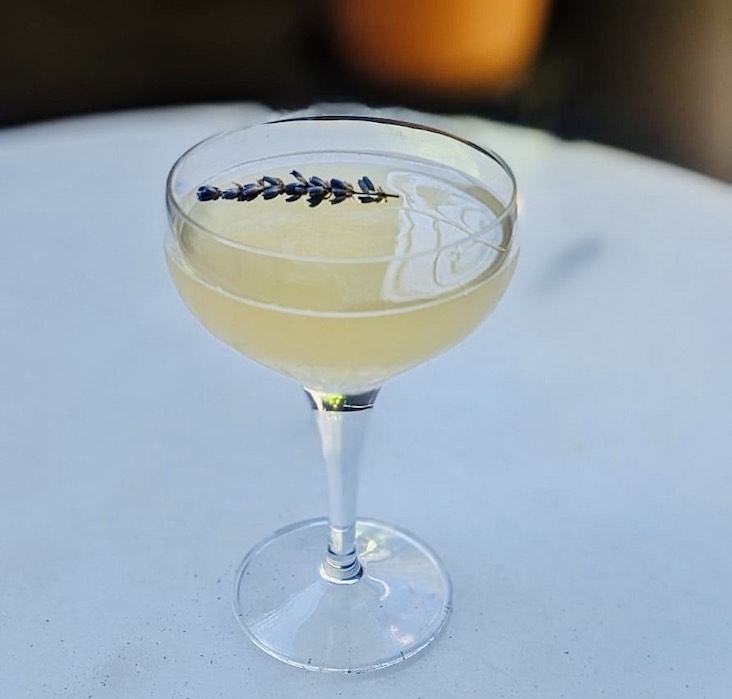MARTINI magic
by Jack Robertiello
photography by
Arthur Cohen
IS THERE ANY STOPPING THE MARTINI JUGGERNAUT?
In New York’s underground lounges, in small-town Pennsylvania saloons, in San Francisco’s trendiest hang-outs, at toney hotel bars and the classiest bistros, the reborn version of the classic American cocktail keeps spawning new, multi-colored permutations.
Where discussions about Martinis and their various recipes once centered on the proper proportion of dry vermouth to gin, today bartenders are called upon to whip up an endless array of Alternatinis made from fruit- and spice-infused spirits laced with brightly-hued liqueurs and splashes of cream, fruit or vegetable juices. And where the choices were once limited to olives, pickled onions and lemon twists, today’s creativity extends to such lily-gilding garnishes as marinated capers, fresh herbs or olives stuffed with blue cheese and sun-dried tomatoes.
Since that evening in the early 1990s when some unknown bartender set off the cocktail revolution by serving the first Cosmopolitan (and someone should quickly lay claim to the distinction of creating that now-standard libation before its origin becomes as disputed as the Martini’s), offering a range of cocktails served in stylish stemware has become essential for an operation to compete.
The 1990s cocktail culture has had such an overwhelming effect on drinking patterns that before too long, what was once the universally agreed-upon meaning of ‘Martini’–gin and a splash of dry vermouth swirled over ice for about 30 seconds–will soon be swept away, leaving behind only the generic term for cocktails served up.
Spirits author Gary Regan, who with his wife Mardee Haidin Regan recently published The Martini Companion (Running Press), a lushly illustrated guide to contemporary and classic Martinis, their history and lore, says the changeover has already occurred.
“Probably due in part to the continuing popularity of new vodka-based drinks, the Martini has become a category rather than a drink. It’s too late to do anything about it, no matter how much of a purist you are. The word ‘Martini’ is being used instead of the word ‘cocktail,’ he concludes.
The Regans themselves try to hold the new Martini definition line at beverages that consist only of mixtures of beverage alcohol; for instance, the Alternating Kurrant Martini served at the Denver’s Purple Martini is acceptable because it’s made of Absolut Kurrant mixed with splashes of Chambord and dry vermouth. But Gary Regan admits the powerful impact of what is arguably the leading fruit juice-flavored Martini. “The Cosmopolitan is the biggest new drink of the decade, no doubt about it,” says Regan. “We have our personal definition of a Martini that we intend to stick to, but to be honest, if it promotes the creation of new drinks, I don’t care what you call it. We went through such a sad time when there were no new cocktails, and people weren’t interested in cocktails. And now due in large part to the proliferation in this Martini category, they’re back in style.”
BLAME IT ON BOND
If Ian Fleming, the creator of James Bond, had any idea what sort of secret weapon he was launching when he armed Bond with a craving for Russian vodka Martinis topped with freshly ground black pepper, perhaps he would have been more careful. After all, no spirit has a greater connection with Mother England than gin. But while Bond, along with Sinatra, Dean Martin and other early 1960s pop icons, has loomed large in the new cocktail culture, it’s more than 007’s image that has made vodka so big. Clearly, says Regan and others, it’s the beverage’s essentially neutral flavor that allows other flavors to merge with it in a way that gin’s assertive taste doesn’t allow.
Gin traditionalists shouldn’t be too haughty; the extremely dry gin Martini only become the standard for the cocktail in the 1950s. Before that, the standard recipe was two or three parts gin to one part dry vermouth, and a dash of orange bitters was de rigeur.
And as Eric Sothern, managing partner of San Francisco’s Infusion points out, gin is strictly speaking already an infused neutral spirit flavored with juniper, and perhaps coriander, licorice, cassia, citrus peel, angelica and other botanicals.
Even at the sort of upscale operation which you would expect to be a fortress of traditional gin Martini drinkers, vodka has made headway. At the Peabody Hotel in Memphis, for instance, the ultimate in Martini service–tableside preparation by the hotel’s executive chef Jose Gutierrez–focuses not on the classic gin Martini, but on four Grey Goose vodka versions: le Martini, le Martini Citron, the French Kiss martini and le Martini Cerises. All four are prepared to order from a silver tray with the vermouth added from an atomizer.
MARTINI EQUALS VODKA?
In some circles, it seems, vodka’s victory is complete. Urs Kaufmann, beverage manager of NY’s Union Pacific and its lounge, Kashmir, says the members of the under-40 crowd populating his newly-opened scene never think of gin when they order Martinis “Especially the top of the line imported vodkas like Belvedere, Chopin and Ketel One, they are driving this trend,” Kaufmann says.
Most of the items on Kashmir’s menu of Martini-inspired cocktails are vodka-based, like the now classic Chocolate Martini, and house specialties like the Kashmirpolitan, made with Stoli strawberry, Cointreau, lime juice and cranberry juice.
The lounge gets an occasional gin Martini drinker, but mostly since it doubles as a smoking lounge and a place for diners to wait while their tables are being prepared upstairs at Union Pacific.
“We still sell an enormous amount of gin Martinis anyway, but the gin drinkers are more traditional in their requests,” says Nick Mautone, general manager of New York’s Gramercy Tavern. He agrees the new Martini trend is a result of vodka’s flexibility; gin, with its pungent aromatic nature, is harder to work with, which may explain why the commercially flavored gins haven’t made the splash that spiked vodkas have.
At the Tavern, known more for its wine collection than cocktails, certain specialty beverages have done well with customers, says Mautone. Two of the most popular, the Rosmarino (rosemary-infused vodka, Pernod and dry vermouth served up with Sicilian caperberries) and the Basil Martini (basil-infused vodka and dry vermouth over ice with a splash of spicy tomato juice) have established a savory connection with food that keeps them at the head of the cocktail menu, which Mautone inaugurated only late last year. The short list is without any of the creamy or sweet Alternatinis, which Mautone frowns on.
GIN TRADITIONALISTS
While vodka-based cocktails have been responsible for the redefinition of the Martini, there are those whose have kept their faith in gin.
“I’m going out on a bit of a limb here, I know, but I think the gin is on its way to a major comeback,” says Regan. With England’s Plymouth gin back on the U.S. market after 20 years, a growing interest in the new Tanqueray Malacca, recently-introduced Dutch Leyden gin and rumors of a new French gin entering the market, Regan says gin is poised for a proper comeback. “Although it’s true right now that vodka leads, I don’t think gin will stand for being pushed out,” he says.
Charlie Ryder, beverage manager of LaSalle Grill, South Bend, IN, remembers how sophisticated gin Martinis seemed to him on his first trip to New York’s Rainbow Room Promenade Bar. The version served there has become his favorite, listed on LaSalle Grill’s menu as the Classic Martini–Beefeater and a splash of Cinzano Dry vermouth, with a twist.
“Vodka is getting more and more popular all the time, but I don’t think gin is being left behind. In addition to my favorite classic gin Martini, we serve our original Crown Jewels, made from Bombay Sapphire and Chambord, which is pretty popular.”
“But the Martini as a category is stronger than ever. It seems to me that we’re getting more of the Gen Xers into it.” He recently added a new twist in honor of the late Swinger-in-Chief; the Sinatra, made his way with Stoli, a dash of vermouth and two olives. “Frank always insisted that his friends share the olives with him by taking one off the spear,” says Ryder.
The Cosmopolitan is one of Ryder’s most popular Alternatinis, in addition to such sweet mixtures as the Lemon Drop–Stoli and fresh lemon juice served with a lemon drop in a sugar-rimmed glass. Ryder says the impact of the new Martinis hasn’t really cut into the gin business, instead taking sales from other categories. Still, gin Martinis tend to be ordered by an older crowd, and he says, it’s the Gen Xer who likes to toy with the vodka combinations.
COCKTAIL CREATIVITY
Barroom creativity hasn’t stopped at new drink recipes, nor at finely-crafted glassware; some operators have polished the sheen on the category with innovative marketing ploys. LaSalle’s Ryder boosts his sales by offering “mini-tinis,” half-portion versions of his 7-ounce cocktails. Ryder also employs olives stuffed with blue cheese, anchovies, almonds, jalape




